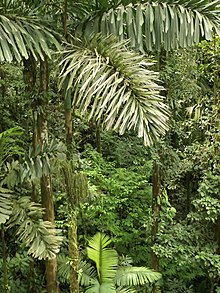Socratea exorrhiza
| Socratea exorrhiza | |
|---|---|

| |
| Scientific classification | |
| Kingdom: | Plantae |
| Clade: | Tracheophytes |
| Clade: | Angiosperms |
| Clade: | Monocots |
| Clade: | Commelinids |
| Order: | Arecales |
| Family: | Arecaceae |
| Genus: | Socratea |
| Species: | S. exorrhiza
|
| Binomial name | |
| Socratea exorrhiza | |
Socratea exorrhiza, the walking palm (Mučka dreva) or cashapona, is a
Function of stilt roots

E. J. H. Corner in 1961 hypothesised that the unusual stilt roots of S. exorrhiza were an adaptation to allow the palm to grow in swampy areas of forest. No evidence exists that stilt roots are in fact an adaptation to flooding, and alternative functions for them have been suggested. John H. Bodley suggested in 1980 that they in fact allow the palm to "walk" away from the point of germination if another tree falls on the seedling and knocks it over. If such an event occurs then the palm produces new vertical stilt roots and can then right itself, the original roots rotting away.[3] Radford writes in the December 2009 Skeptical Inquirer that "As interesting as it would be to think that when no one is around trees walk the rainforest floor, it is a mere myth", and cites two detailed studies that came to this conclusion.[4][5][6] Other advantages of stilt roots over normal roots have since been proposed. Swaine proposed in 1983 that they allow the palm to colonise areas where there is much debris (for example, dead logs) as they can avoid it by moving their roots. Hartshorn suggested in 1983 that stilt roots allow the palm to grow upwards to reach light without having to increase the diameter of the stem. The roots make the palm more stable and therefore allow it to grow taller and more quickly than if they did not possess them. They also allow the palm to invest less biomass in underground roots than other palms, therefore leaving more energy to be used in growing above ground. It was also thought that the roots may confer an advantage when the palm is growing on a slope, but no evidence has been found that this is the case.[5]
Iriartea has similar stilt roots to S. exorrhiza.[3]
Epiphytes


Many different species of
Leaf morphology
Leaves of S. exorrhiza that grow in the sun are thicker, have more trichomes and more stomata than those that grow in the shade.[7]
Predators
Reproduction
Socratea exorrhiza flowers mostly during the dry season
Uses[12]
The trunk is used in the construction of houses and other structures, as well as hunting spears.[13][14] It is usually split lengthwise before it is used, but it can also be hollowed out and used as a tube. The inner parts of the stilt roots are used as a male aphrodisiac.[15] The yellow fruits are edible.[13] The leaves may be used to build a temporary shelter or more permanent hut roofs.[16] A harpoon foreshaft identified as wood of the palm was found with a large flaked lithic projectile point in an underwater preceramic site the middle Xingu.[17]
References
- ^ S2CID 56431960. Archived from the original(PDF) on 2011-08-27.
- ^ Michael J. Balick (Summer 1985). "The indigenous palm flora of "Las Gaviotas" Colombia, including observations on local names and uses". 30 (3): 10.
{{cite journal}}: Cite journal requires|journal=(help) - ^ JSTOR 2387775.
- ^ Radford, Benjamin (December 2009). "The Myth of the Walking Tree". Skeptical Inquirer. 33 (6). Committee for Skeptical Inquiry: 23.
- ^ S2CID 9306195.
- PMID 19086384. Archived from the original(PDF) on 2012-02-28. Retrieved 2009-09-29.
- JSTOR 2445651.
- S2CID 6351071.
- S2CID 19350190.
- ^ "Pollination of Amazon palms". Archived from the original on 2009-01-31. Retrieved 2009-09-29.
- JSTOR 3072281.
- ISSN 1984-6215.
- ^ a b "Botanical Museum leaflets, Harvard University". 29. 1983.
{{cite journal}}: Cite journal requires|journal=(help) - ^ "Socratea exorrhiza (Cashapona) « Rainforest Conservation Fund". Archived from the original on 2017-09-17. Retrieved 2011-04-12.
The trunk is used in the construction of houses and other structures.
- ^ "Socratea exorrhiza (Cashapona) « Rainforest Conservation Fund". Archived from the original on 2017-09-17. Retrieved 2011-04-12.
The inner part of the stilt roots is used as a male aphrodisiac.
- ISSN 1020-3370.
- ^ A. Roosevelt et al. 2009
